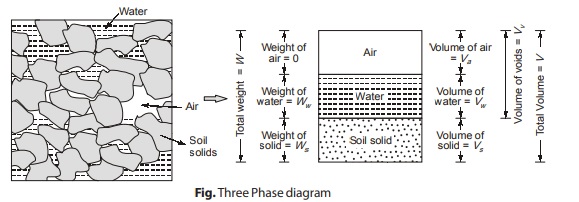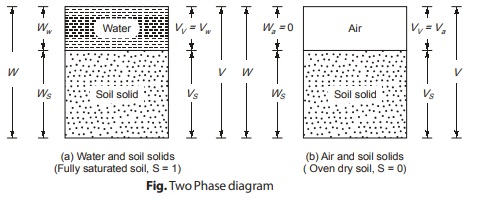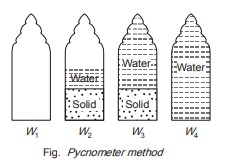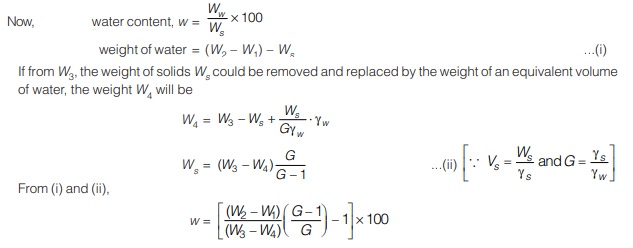Phase Diagram
- Soil mass, in general is a three phase system composed of solid, liquid and gaseous phase.
- Different phases present in soil mass cannot be separated. For better understanding, all three constituents are assumed to occupy separate spaces as shown in figure below.

- In phase diagrams, the weight of air is negligible as compared to soil solid and water and is thus assumed to be zero. The diagrammatic representation of the different phases in a soil mass is called the ‘phase diagram’, or ‘block diagram’. A three-phase diagram is applicable for a partially saturated soil (0 < S < 1)
- When all the voids are filled with water, the sample becomes saturated and thus the gaseous phase is absent; whereas, in oven dry soil sample the liquid phase is absent. Thus, in saturated and oven dry soils, the three phase system reduces to two phase system.

METHODS FOR DETERMINATION OF WATER CONTENT
- Water content of soil is an important soil parameter which significantly influences the behavior of mainly cohesive soil. The determination of water content should be done immediately after soil sample is brought to laboratory and just prior to commencing any other test on that soil sample.
- Water content can be determined by any one of the following methods.
Oven Drying Method
- This is the simplest and most accurate method.
- For inorganic soils, temperature is controlled between 105-110°C.
- For soil containing organic compounds, temperature is maintained about 60°C and if Gypsum is present, then temperature should be maintained at 80°C.
- Usually 4 – 6 hrs are enough for sands to dry but 16 – 20 hrs are required for clay. Usually 24 hrs are provided for drying in the oven.
- If temperature is uncontrolled and more than 110°C, there is a danger of loss of structural water.
- Water content is calculated as follows.
W1 = Weight of empty container
W2 = Weight of container + moist soil
W3 = Weight of container + dry soil
Ww (weight of water) = W2 – W3
Ws = W3 – W1
W = Ww /Ws x 100
W = W2 – W3 / W3 – W1 x 100
This method is most accurate but time consuming.
Pycnometer Method 
- This is a quick method but it is less accurate than oven drying method.
- This method is used only when specific gravity of soil solids is known.
- A small weight, say 200 g to 400 g of soil is placed in a clean pycnometer whose capacity is 900 ml.
- Let W1 = Weight of empty pycnometer bottle
W2 = Weight of pycnometer + soil
W3 = Weight of pycnometer + soil + water
W4 = Weight of pycnometer + water - Let G be specific gravity of soil solids,

Calcium Carbide Method / Rapid Moisture Meter Method
- It is very quick method, takes only 5 to 7 minutes but may not give accurate results.
- A soil sample of weight 4 – 6 gms is placed in moisture testing equipment. The equipment consists of a closed chamber in which calibrated scale is connected to measure the pressure exerted which is directly co-related to water content.
- Calcium carbide powder (CaC2) is added on the moist soil sample which reacts with the water and as a result acetylene gas is removed which exerts pressure.

- The water content recorded is expressed as a % of moist weight of soil, whereas actual water content is expressed as a fraction of dry weight of soil.
Let wr = Moisture content recorded, expressed as a fraction of moist weight of soil
w = Actual water content


